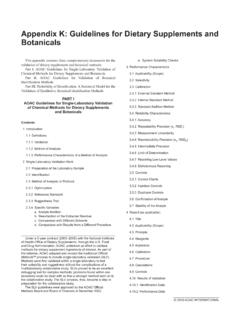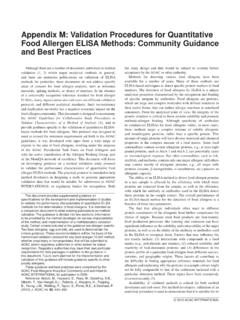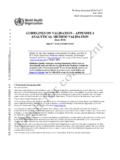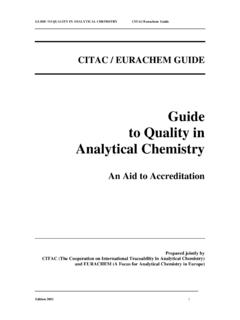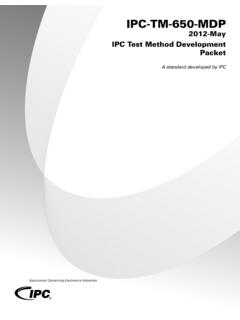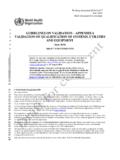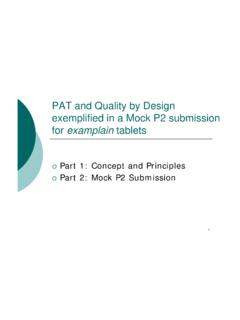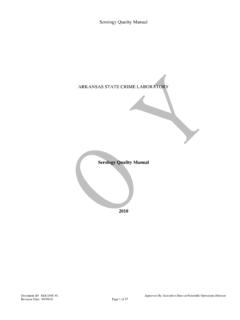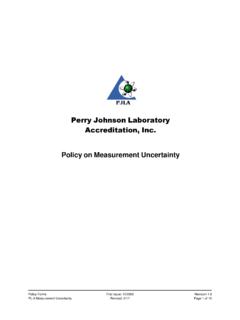Transcription of Appendix F: Guidelines for Standard Method …
1 2016 AOAC INTERNATIONALC ontentsIntroduction to Standard Method performance requirements 1 Annex A: Format of a Standard Method performance Requirement 5 Annex B: Classification of methods 11 Annex C: Understanding the POD Model 12 Annex D: Definitions and Calculations of HorRat Values from Intralaboratory Data 13 Annex E: AOAC Method Accuracy Review 15 Annex F: Development and Use of In-House Reference Materials 16 Introduction to Standard Method performance RequirementsStandard Method performance requirements (SMPRs ) are a unique and novel concept for the analytical methods community. SMPRs are voluntary consensus standards , developed by stakeholders, that prescribe the minimum analytical performance requirements for classes of analytical methods .
2 In the past, analytical methods were evaluated and the results compared to a gold Standard Method , or if a gold Standard Method did not exist, then reviewers would decide retrospectively if the analytical performance was acceptable. Frequently, Method developers concentrated on the process of evaluating the performance parameters of a Method , and rarely set acceptance criteria. However, as the Eurachem Guide points out: .. the judgment of Method suitability for its intended use is equally important .. (1) to the evaluation Voluntary Consensus StandardsAn SMPR is a form of an international, voluntary consensus Standard . A Standard is an agreed, repeatable way of doing something that is published as document that contains a technical specification or other precise criteria designed to be used consistently as a rule, guideline, or definition.
3 SMPRs are a consensus standards developed by stakeholders in a very controlled process that ensures that users, research organizations, government departments, and consumers work together to create a Standard that meets the demands of the analytical community and technology. SMPRs are also voluntary standards . AOAC cannot, and does not, impose the use of SMPRs. Users are free to use SMPRs as they see fit. AOAC is very careful to include participants from as many regions of the world as possible so that SMPRs are accepted as international for Standard Method performance RequirementsCommonly known as the SMPR Guidelines . The first version of the SMPR Guidelines were drafted in 2010 in response to the increasing use and popularity of SMPRs as a vehicle to describe the analytical requirements of a Method .
4 Several early acceptance criteria documents were prepared for publication in late 2009, but the format of the acceptance criteria documents diverged significantly from one another in basic format. AOAC realized that a guidance document was needed to promote early version of the SMPR Guidelines were used for a project to define the analytical requirements for endocrine disruptors in potable water. The Guidelines proved to be extremely useful in guiding the work of the experts and resulted in uniform SMPRs. Subsequent versions of the SMPR Guidelines were used in the AOAC Stakeholder Panel on Infant Formula and Adult Nutritionals (SPIFAN) project with very positive results. The SMPR Guidelines are published in the Journal of AOAC INTERNATIONAL and Official methods of of the Guidelines are advised that they are: (1) a guidance document, not a statute that users must conform to; and (2) a living document that is regularly updated, so users should check the AOAC website for the latest version before using these SMPR Guidelines are intended to provide basic information for working groups assigned to prepare SMPRs.
5 The Guidelines consist of the Standard format of an SMPR, followed by a series of informative tables and FormatThe general format for an SMPR is provided in Annex SMPR is identified by a unique SMPR number consisting of the year followed by a sequential identification number ( ). An SMPR number is assigned when the Standard is approved. By convention, the SMPR number indicates the year a Standard is approved (as opposed to the year the Standard is initiated). For example, SMPR indicates the third SMPR adopted in SMPR number is followed by a Method name that must include the analyte(s), matrix(es), and analytical technique (unless the SMPR is truly intended to be independent of the analytical technology).
6 The Method name may also refer to a common name ( , Kjeldahl Method ).The SMPR number and Method name are followed by the name of the stakeholder panel or expert review panel that approved the SMPR, and the approval and effective about Method requirements is itemized into nine categories: (1) intended use; (2) applicability; (3) analytical technique; (4) definitions; (5) Method performance requirements ; (6) system suitability; (7) reference materials; (8) validation guidance; and (9) maximum SMPR for qualitative and/or identification methods may include up to three additional annexes: (1) inclusivity/selectivity panel; (2) exclusivity/cross-reactivity panel; and (3) environmental material panels.
7 These annexes not tables. The SMPR Guidelines contain seven informative tables that represent the distilled knowledge of many years of Method evaluation, and are intended as guidance for SMPR working groups. The informative tables are not necessarily AOAC Appendix F: Guidelines for Standard Method performance requirements 2016 AOAC INTERNATIONALG uidelines for Standard Method performance requirements AOAC Official methods of Analysis (2016) Appendix F, p. 2policy. SMPR working groups are expected to apply their expertise in the development of A1: performance requirements . Provides recommended performance parameters to be included into an SMPR. Table A1 is organized by five Method classifications: (1) main component quantitative methods ; (2) trace or contaminant quantitative methods ; (3) main component qualitative methods ; (4) trace or contaminant quantitative methods ; and (5) identification methods .
8 The table is designed to accommodate both microbiological and chemical methods . Alternate microbiological/chemical terms are provided for equivalent A2: Recommended Definitions. Provides definitions for Standard terms in the SMPR Guidelines . AOAC relies on The International Vocabulary of Metrology Basic and General Concepts and Associated Terms (VIM) and the International Organization for Standadization (ISO) for definition of terms not included in Table A3: Recommendations for Evaluation. Provides general guidance for evaluation of performance parameters. More detailed evaluation guidance can be found in Appendix D, Guidelines for Collaborative Study Procedures to Validate Characteristics of a Method of Analysis (2); Appendix I, Guidelines for Validation of Biological Threat Agent methods and/or Procedures (3); Appendix K, AOAC Guidelines for Single-Laboratory Validation of Chemical methods for Dietary Supplements and Botanicals (4); Codex Alimentarius Codex Procedure Manual (5); and ISO Standard 5725-1-1994 (6).
9 Table A4: Expected Precision (Repeatability) as a Function of Analyte Concentration. The precision of a Method is the closeness of agreement between independent test results obtained under stipulated conditions. Precision is usually expressed in terms of imprecision and computed as a relative Standard deviation (RSD) of the test results. The imprecision of a Method increases as the concentration of the analyte decreases. This table provides target RSDs for a range of analyte A5: Expected Recovery as a Function of Analyte Concentration. Recovery is defined as the ratio of the observed mean test result to the true value. The range of the acceptable mean recovery expands as the concentration of the analyte decreases.
10 This table provides target mean recovery ranges for analyte concentrations from 1 ppb to 100%.Table A6: Predicted Relative Standard Deviation of Reproducibility (PRSDR). This table provides the calculated PRSDR using the Horwitz formula:PRSDR = 2C C is expressed as a mass A7: POD and Number of Test Portions. This table provides the calculated probability of detection (POD) for given sample sizes and events (detections). A Method developer can use this table to determine the number of analyses required to obtain a specific annexes. The SMPR Guidelines contain informative annexes on the topics of classification of methods , POD model, HorRat values, reference materials, and Method accuracy and review.
